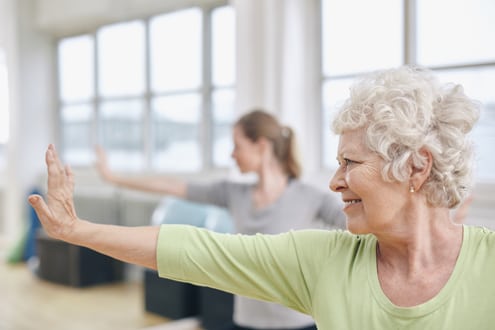Body positioning can make a huge difference to how you look and feel. All it takes is some simple modifications done on a regular basis and you will start to feel changes in your appearance and overall comfort. This will also transform into increased energy, improved athletic performance and lower the risk of injury.
Learning to control your body through the mind and other mind techniques are ancient concepts, once only mastered by people in the East, but now becoming a very popular and common area in the exercise world.
These are the 4 mind-body fitness options:
1. Pilates
Named after Joseph H Pilates, a carpenter who developed this unique exercise system in the 1920s for injured dancers, Pilates has now become an extremely popular fitness class with 55 Pilates studios now situated across the country. In addition there are many instruction videos and books on the fitness programme. It can be sometimes taught under other names such as ‘the method’ or ‘Re:Ab’.
Pilates can be performed in two ways: Private lessons on specially designed equipment or a group ‘mat’ class. You won’t do a lot of repetitions of each move, but it is intense work even for those who are extremely fit.
The benefits include, extra strength gained without added bulk and the stretching of muscles as it creates postural awareness. Pilates focuses on the ‘powerhouse’ muscles including the abs, bum, thighs and back.
2. Yoga
Yoga has existed for more than 5,000 years. It was developed in India and is now become more popular than ever, especially with people in the West. Many Yoga classes have a spiritual element, and there are a range of different styles of yoga that can be taken up to suit everyone’s needs.
Yoga generally consists of a series of poses and postures that are performed while focusing on your breathing and mind relaxation. Some classes involve chanting, prayer, candles or incense or can be taught alongside certain religions.
The benefits include deep relaxation, mind-calming, body awareness, strength and flexibility, and stress reduction.
3. Qi gong
Qi gong is an ancient Chinese exercise that was originally prescribed as a treatment for illness. Nowadays it is enjoyed all over the world as a gentle way to stretch and strengthen the body as well as calming the mind. It’s less structured and technical compared to Pilates or Yoga, so there is not much of a learning curve.
It includes the practicing of meditation, visualisation, breathing and slow and easy movements to help you restore the balance of qi (chee), known as the life-giving force, and also help remove energy blockages. Some classes can be quite similar to Yoga in terms of poses and positioning, while in others your teacher may ask you to move spontaneously, roll objects between your palms or meditate while walking slowly.
Qi gong will help you with relaxation but at the same time provide you with an energetic feel. It teaches you how to breathe properly, improve flexibility and strength and is for all – no age restrictions or fitness levels required.
4. Alexander Technique
Developed by an Australian-born actor nearly 100 years ago (early 1900s) it focuses on the re-teaching of everyday movement patterns to achieve big differences in body awareness, posture and body comfort. Several thousand Alexander Technique instructors can now be found worldwide due to its growing popularity.
Basic activities are performed such as standing up and walking while an Alexander teacher gives you cues and adjustments to help you move more easily with less effort.
Much of the work practiced in classes is very delicate and concentrates on positioning of the head, neck and torso.
The Alexander Technique helps you free your muscles from tension that may be impeding movement or causing you pain. It also helps restore muscular balance by increasing awareness of how muscles should operate; in the process helps you unlearn poor postural habits and movement patterns.




